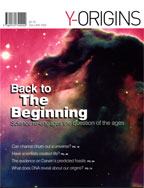A GREAT BRAIN'S BIGGEST BLUNDER
When Albert Einstein developed his revolutionary theory of general relativity in 1916, his mathematical calculations pointed to an extraordinary conclusion—the universe was expanding. And since if you rewind the tape on any expansion, you get back to a point where it started, that meant the universe must have had a beginning too.1
Einstein, however, was like most scientists of his day in that he believed in an eternal universe. Unwilling to accept a beginning to the universe, Einstein fudged the numbers in order to nullify the conclusion that the universe was expanding.
University of California astrophysicist George Smoot explains that Einstein’s main problem with an expanding universe was its implication of a beginning. A beginning pointed to a beginner beyond scientific investigation.2 However, once experimental data proved that the universe really was expanding, Einstein admitted his error, calling it “the biggest blunder of my life.”3
There’s a point worth considering here: if it could happen to Einstein, it could happen to anyone. Rarely is anyone completely objective when it comes to the issue of a Creator. While it is true that religious belief and philosophy became an obstacle for scientific inquiry in the days of Galileo, trends have changed. In the modern era it has at times been a prejudice against the possibility of a cosmic designer that has kept many scientists from honest and open inquiry.
Thankfully, the truth generally comes out in the end and scientists begin to see the light. For Einstein and others, it was something called red shift that started the parade of evidence for a universe with a beginning.
Back | Endnotes | Next
|




